SUS207 Research Essay: Exploring the Causes and Solutions to Famine
VerifiedAdded on 2023/04/11
|12
|3231
|241
Essay
AI Summary
This essay provides a detailed analysis of the causes of famine, drawing upon Amartya Sen's hypothesis that famine is not merely a result of food unavailability but rather a lack of access to food for certain segments of society. It explores multiple factors contributing to famine, including political instability, war, drought, and ineffective policies. The essay examines historical examples and international aid efforts, highlighting instances where famine has been used as a political tool. It also considers the impact of factors like the AIDS epidemic on food security. The analysis extends to the role of overpopulation, climate change, natural disasters, and government mismanagement in exacerbating famine conditions. Ultimately, the essay emphasizes the need for comprehensive solutions that address both the immediate and underlying causes of famine, advocating for stable governance, effective resource management, and equitable access to food.
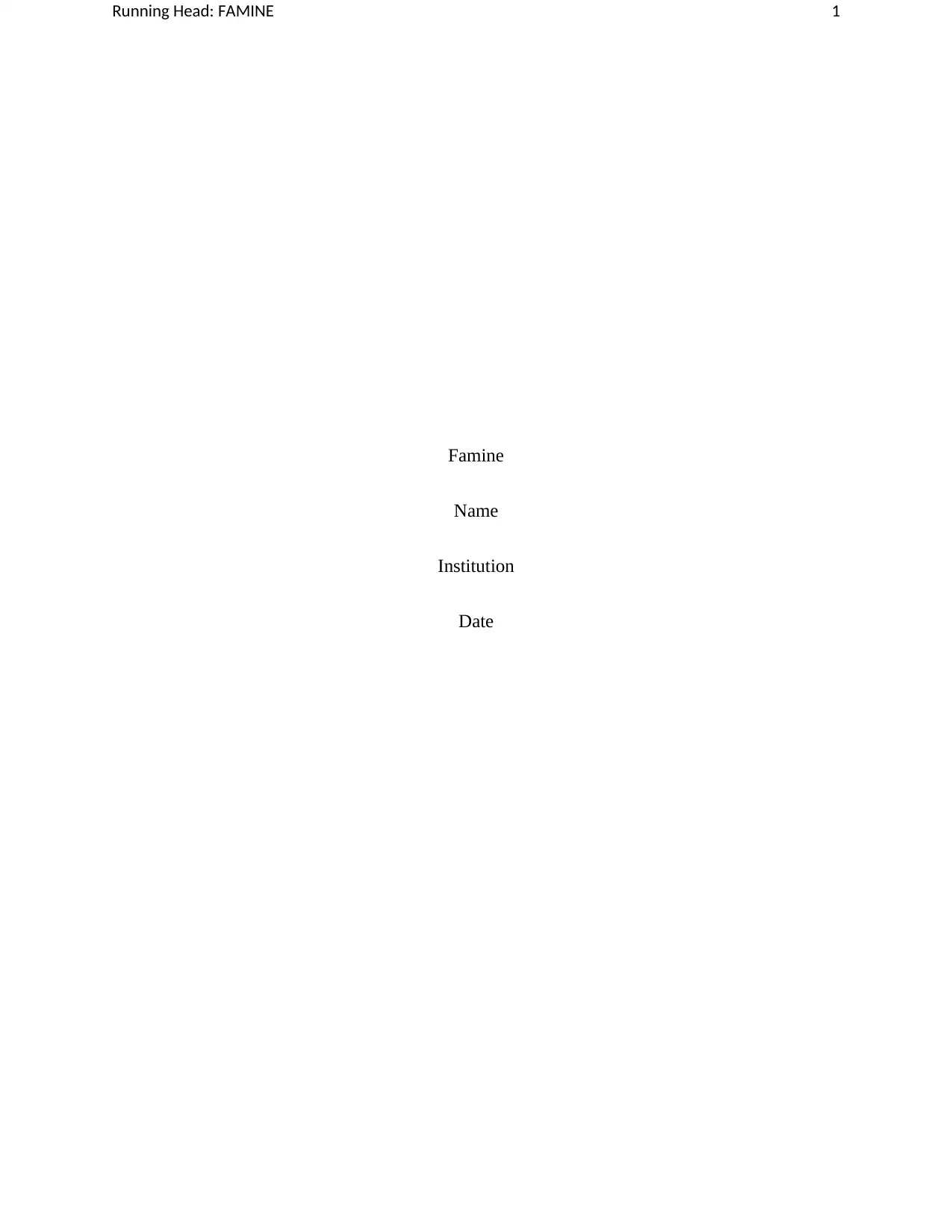
Running Head: FAMINE 1
Famine
Name
Institution
Date
Famine
Name
Institution
Date
Paraphrase This Document
Need a fresh take? Get an instant paraphrase of this document with our AI Paraphraser
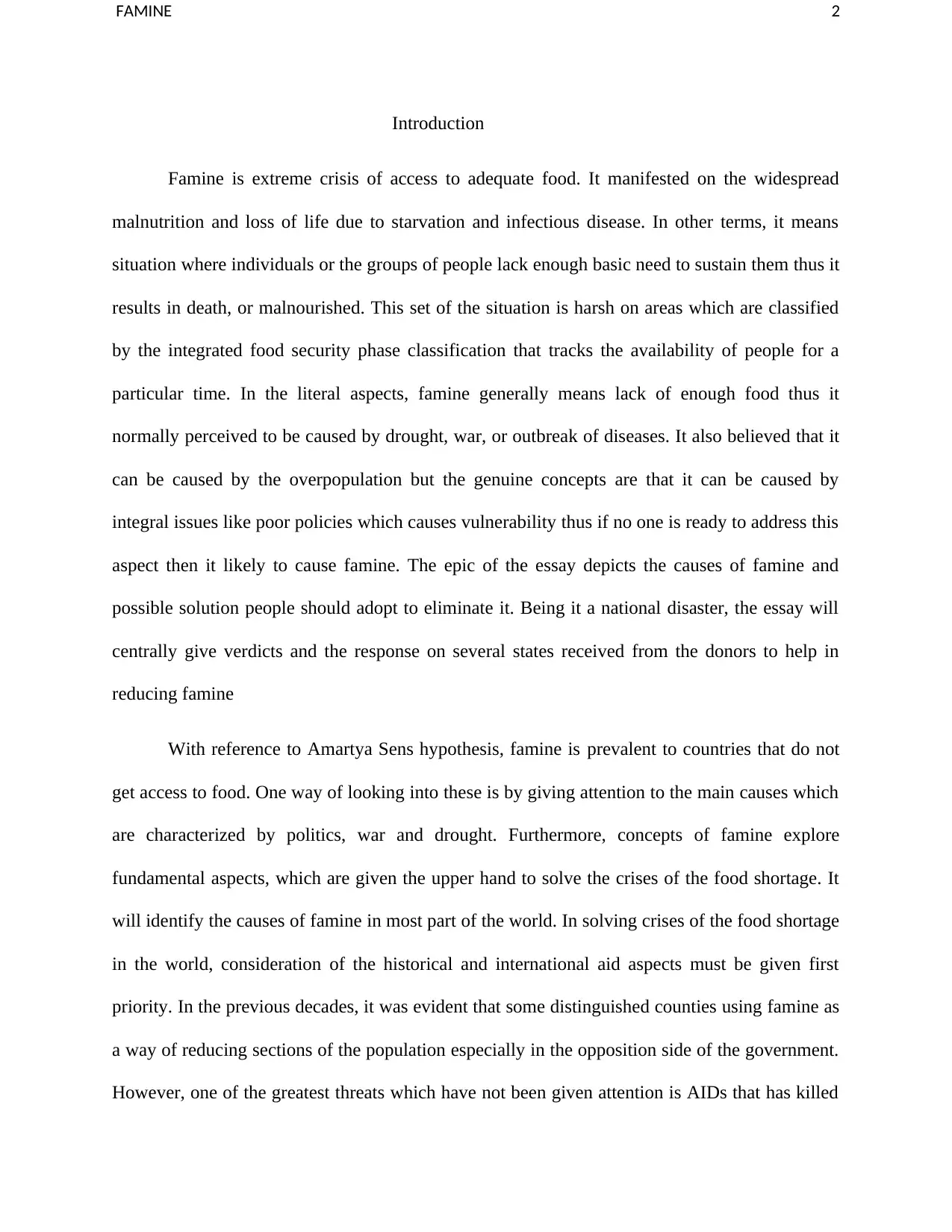
FAMINE 2
Introduction
Famine is extreme crisis of access to adequate food. It manifested on the widespread
malnutrition and loss of life due to starvation and infectious disease. In other terms, it means
situation where individuals or the groups of people lack enough basic need to sustain them thus it
results in death, or malnourished. This set of the situation is harsh on areas which are classified
by the integrated food security phase classification that tracks the availability of people for a
particular time. In the literal aspects, famine generally means lack of enough food thus it
normally perceived to be caused by drought, war, or outbreak of diseases. It also believed that it
can be caused by the overpopulation but the genuine concepts are that it can be caused by
integral issues like poor policies which causes vulnerability thus if no one is ready to address this
aspect then it likely to cause famine. The epic of the essay depicts the causes of famine and
possible solution people should adopt to eliminate it. Being it a national disaster, the essay will
centrally give verdicts and the response on several states received from the donors to help in
reducing famine
With reference to Amartya Sens hypothesis, famine is prevalent to countries that do not
get access to food. One way of looking into these is by giving attention to the main causes which
are characterized by politics, war and drought. Furthermore, concepts of famine explore
fundamental aspects, which are given the upper hand to solve the crises of the food shortage. It
will identify the causes of famine in most part of the world. In solving crises of the food shortage
in the world, consideration of the historical and international aid aspects must be given first
priority. In the previous decades, it was evident that some distinguished counties using famine as
a way of reducing sections of the population especially in the opposition side of the government.
However, one of the greatest threats which have not been given attention is AIDs that has killed
Introduction
Famine is extreme crisis of access to adequate food. It manifested on the widespread
malnutrition and loss of life due to starvation and infectious disease. In other terms, it means
situation where individuals or the groups of people lack enough basic need to sustain them thus it
results in death, or malnourished. This set of the situation is harsh on areas which are classified
by the integrated food security phase classification that tracks the availability of people for a
particular time. In the literal aspects, famine generally means lack of enough food thus it
normally perceived to be caused by drought, war, or outbreak of diseases. It also believed that it
can be caused by the overpopulation but the genuine concepts are that it can be caused by
integral issues like poor policies which causes vulnerability thus if no one is ready to address this
aspect then it likely to cause famine. The epic of the essay depicts the causes of famine and
possible solution people should adopt to eliminate it. Being it a national disaster, the essay will
centrally give verdicts and the response on several states received from the donors to help in
reducing famine
With reference to Amartya Sens hypothesis, famine is prevalent to countries that do not
get access to food. One way of looking into these is by giving attention to the main causes which
are characterized by politics, war and drought. Furthermore, concepts of famine explore
fundamental aspects, which are given the upper hand to solve the crises of the food shortage. It
will identify the causes of famine in most part of the world. In solving crises of the food shortage
in the world, consideration of the historical and international aid aspects must be given first
priority. In the previous decades, it was evident that some distinguished counties using famine as
a way of reducing sections of the population especially in the opposition side of the government.
However, one of the greatest threats which have not been given attention is AIDs that has killed
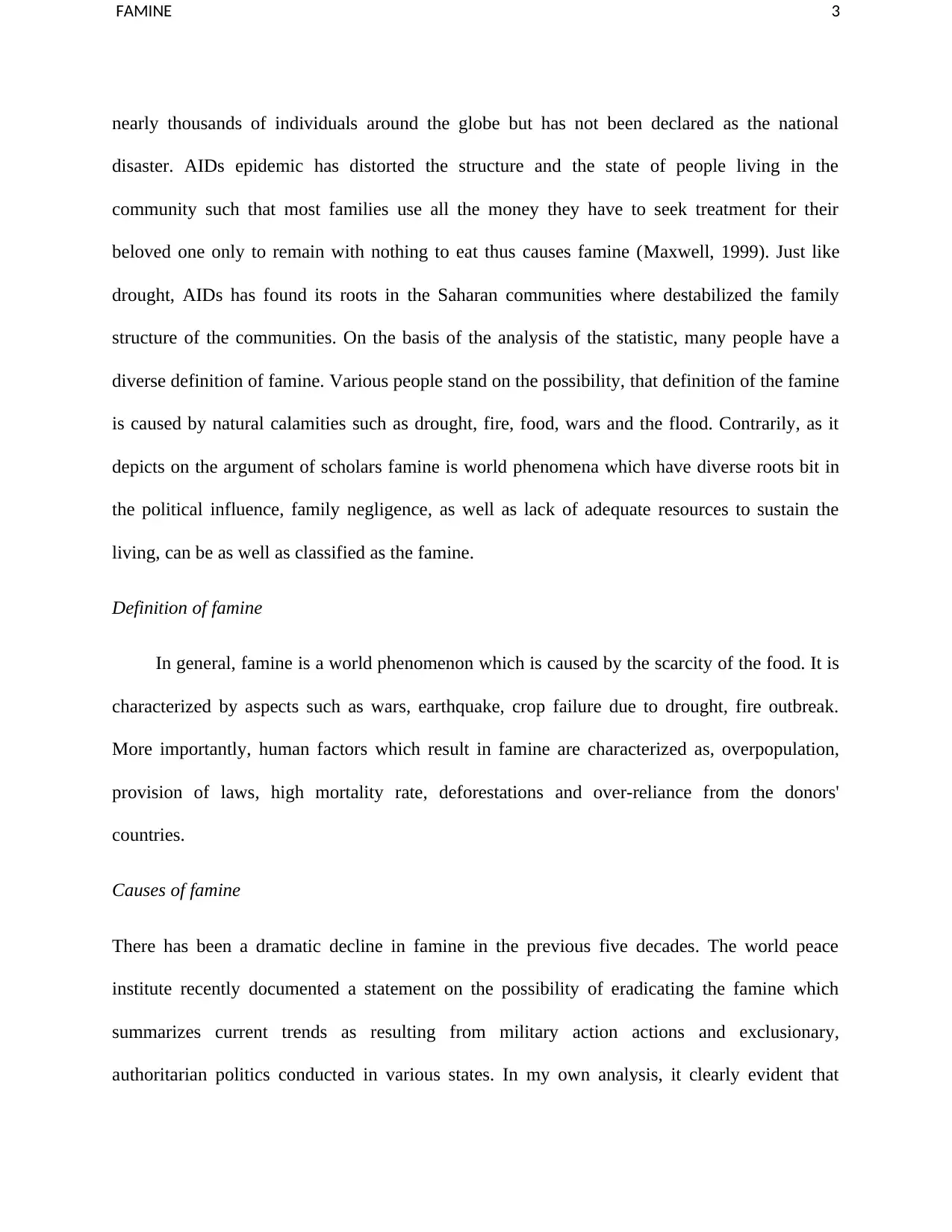
FAMINE 3
nearly thousands of individuals around the globe but has not been declared as the national
disaster. AIDs epidemic has distorted the structure and the state of people living in the
community such that most families use all the money they have to seek treatment for their
beloved one only to remain with nothing to eat thus causes famine (Maxwell, 1999). Just like
drought, AIDs has found its roots in the Saharan communities where destabilized the family
structure of the communities. On the basis of the analysis of the statistic, many people have a
diverse definition of famine. Various people stand on the possibility, that definition of the famine
is caused by natural calamities such as drought, fire, food, wars and the flood. Contrarily, as it
depicts on the argument of scholars famine is world phenomena which have diverse roots bit in
the political influence, family negligence, as well as lack of adequate resources to sustain the
living, can be as well as classified as the famine.
Definition of famine
In general, famine is a world phenomenon which is caused by the scarcity of the food. It is
characterized by aspects such as wars, earthquake, crop failure due to drought, fire outbreak.
More importantly, human factors which result in famine are characterized as, overpopulation,
provision of laws, high mortality rate, deforestations and over-reliance from the donors'
countries.
Causes of famine
There has been a dramatic decline in famine in the previous five decades. The world peace
institute recently documented a statement on the possibility of eradicating the famine which
summarizes current trends as resulting from military action actions and exclusionary,
authoritarian politics conducted in various states. In my own analysis, it clearly evident that
nearly thousands of individuals around the globe but has not been declared as the national
disaster. AIDs epidemic has distorted the structure and the state of people living in the
community such that most families use all the money they have to seek treatment for their
beloved one only to remain with nothing to eat thus causes famine (Maxwell, 1999). Just like
drought, AIDs has found its roots in the Saharan communities where destabilized the family
structure of the communities. On the basis of the analysis of the statistic, many people have a
diverse definition of famine. Various people stand on the possibility, that definition of the famine
is caused by natural calamities such as drought, fire, food, wars and the flood. Contrarily, as it
depicts on the argument of scholars famine is world phenomena which have diverse roots bit in
the political influence, family negligence, as well as lack of adequate resources to sustain the
living, can be as well as classified as the famine.
Definition of famine
In general, famine is a world phenomenon which is caused by the scarcity of the food. It is
characterized by aspects such as wars, earthquake, crop failure due to drought, fire outbreak.
More importantly, human factors which result in famine are characterized as, overpopulation,
provision of laws, high mortality rate, deforestations and over-reliance from the donors'
countries.
Causes of famine
There has been a dramatic decline in famine in the previous five decades. The world peace
institute recently documented a statement on the possibility of eradicating the famine which
summarizes current trends as resulting from military action actions and exclusionary,
authoritarian politics conducted in various states. In my own analysis, it clearly evident that
⊘ This is a preview!⊘
Do you want full access?
Subscribe today to unlock all pages.

Trusted by 1+ million students worldwide
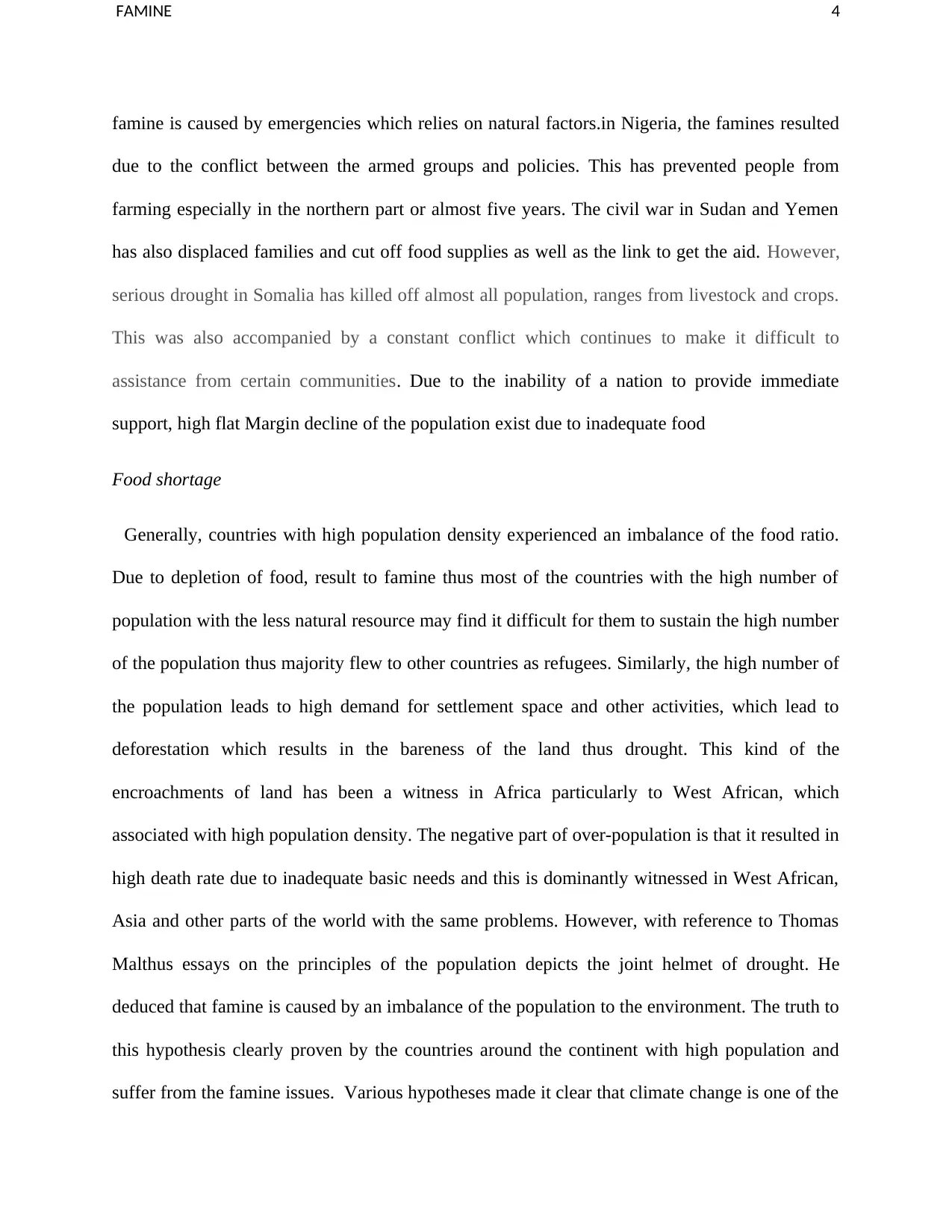
FAMINE 4
famine is caused by emergencies which relies on natural factors.in Nigeria, the famines resulted
due to the conflict between the armed groups and policies. This has prevented people from
farming especially in the northern part or almost five years. The civil war in Sudan and Yemen
has also displaced families and cut off food supplies as well as the link to get the aid. However,
serious drought in Somalia has killed off almost all population, ranges from livestock and crops.
This was also accompanied by a constant conflict which continues to make it difficult to
assistance from certain communities. Due to the inability of a nation to provide immediate
support, high flat Margin decline of the population exist due to inadequate food
Food shortage
Generally, countries with high population density experienced an imbalance of the food ratio.
Due to depletion of food, result to famine thus most of the countries with the high number of
population with the less natural resource may find it difficult for them to sustain the high number
of the population thus majority flew to other countries as refugees. Similarly, the high number of
the population leads to high demand for settlement space and other activities, which lead to
deforestation which results in the bareness of the land thus drought. This kind of the
encroachments of land has been a witness in Africa particularly to West African, which
associated with high population density. The negative part of over-population is that it resulted in
high death rate due to inadequate basic needs and this is dominantly witnessed in West African,
Asia and other parts of the world with the same problems. However, with reference to Thomas
Malthus essays on the principles of the population depicts the joint helmet of drought. He
deduced that famine is caused by an imbalance of the population to the environment. The truth to
this hypothesis clearly proven by the countries around the continent with high population and
suffer from the famine issues. Various hypotheses made it clear that climate change is one of the
famine is caused by emergencies which relies on natural factors.in Nigeria, the famines resulted
due to the conflict between the armed groups and policies. This has prevented people from
farming especially in the northern part or almost five years. The civil war in Sudan and Yemen
has also displaced families and cut off food supplies as well as the link to get the aid. However,
serious drought in Somalia has killed off almost all population, ranges from livestock and crops.
This was also accompanied by a constant conflict which continues to make it difficult to
assistance from certain communities. Due to the inability of a nation to provide immediate
support, high flat Margin decline of the population exist due to inadequate food
Food shortage
Generally, countries with high population density experienced an imbalance of the food ratio.
Due to depletion of food, result to famine thus most of the countries with the high number of
population with the less natural resource may find it difficult for them to sustain the high number
of the population thus majority flew to other countries as refugees. Similarly, the high number of
the population leads to high demand for settlement space and other activities, which lead to
deforestation which results in the bareness of the land thus drought. This kind of the
encroachments of land has been a witness in Africa particularly to West African, which
associated with high population density. The negative part of over-population is that it resulted in
high death rate due to inadequate basic needs and this is dominantly witnessed in West African,
Asia and other parts of the world with the same problems. However, with reference to Thomas
Malthus essays on the principles of the population depicts the joint helmet of drought. He
deduced that famine is caused by an imbalance of the population to the environment. The truth to
this hypothesis clearly proven by the countries around the continent with high population and
suffer from the famine issues. Various hypotheses made it clear that climate change is one of the
Paraphrase This Document
Need a fresh take? Get an instant paraphrase of this document with our AI Paraphraser
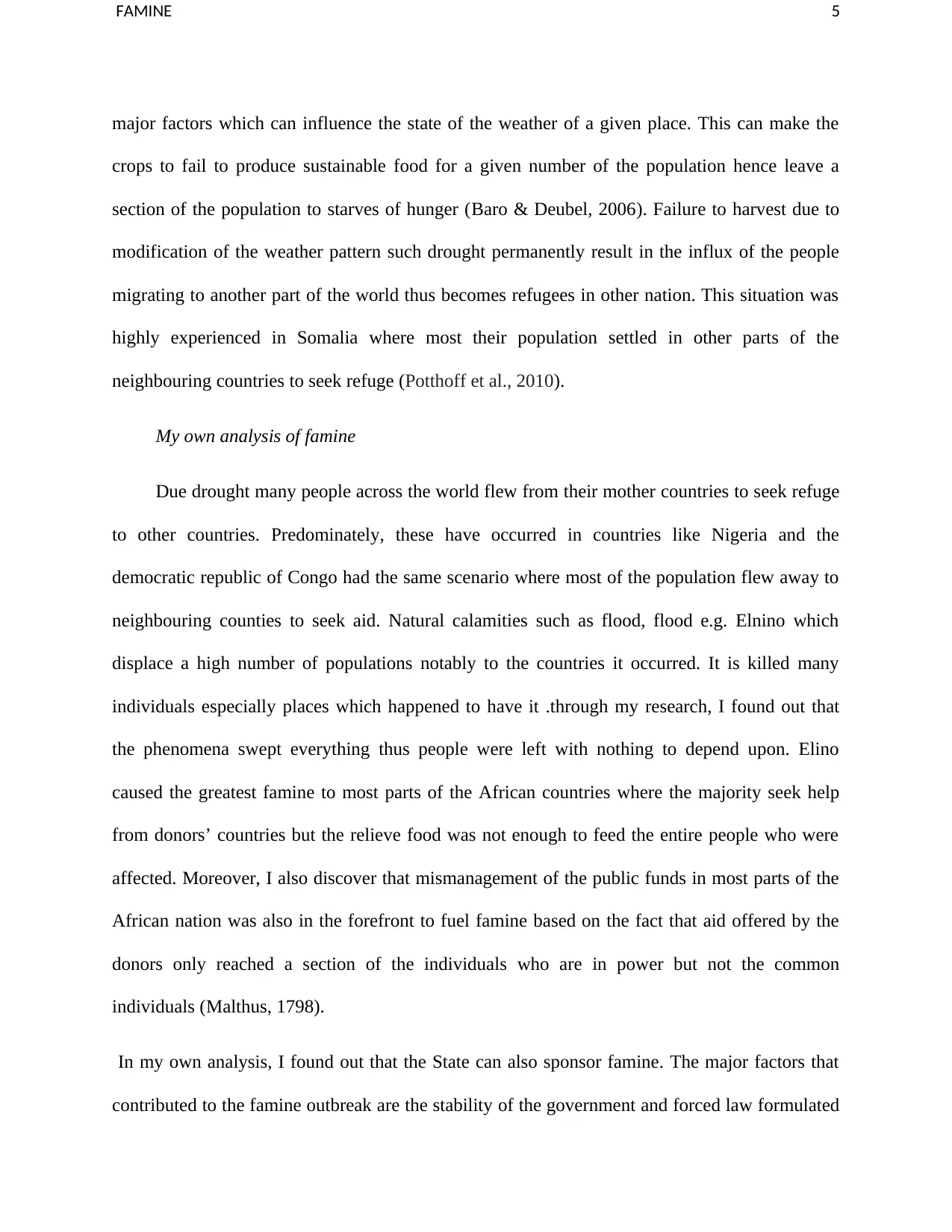
FAMINE 5
major factors which can influence the state of the weather of a given place. This can make the
crops to fail to produce sustainable food for a given number of the population hence leave a
section of the population to starves of hunger (Baro & Deubel, 2006). Failure to harvest due to
modification of the weather pattern such drought permanently result in the influx of the people
migrating to another part of the world thus becomes refugees in other nation. This situation was
highly experienced in Somalia where most their population settled in other parts of the
neighbouring countries to seek refuge (Potthoff et al., 2010).
My own analysis of famine
Due drought many people across the world flew from their mother countries to seek refuge
to other countries. Predominately, these have occurred in countries like Nigeria and the
democratic republic of Congo had the same scenario where most of the population flew away to
neighbouring counties to seek aid. Natural calamities such as flood, flood e.g. Elnino which
displace a high number of populations notably to the countries it occurred. It is killed many
individuals especially places which happened to have it .through my research, I found out that
the phenomena swept everything thus people were left with nothing to depend upon. Elino
caused the greatest famine to most parts of the African countries where the majority seek help
from donors’ countries but the relieve food was not enough to feed the entire people who were
affected. Moreover, I also discover that mismanagement of the public funds in most parts of the
African nation was also in the forefront to fuel famine based on the fact that aid offered by the
donors only reached a section of the individuals who are in power but not the common
individuals (Malthus, 1798).
In my own analysis, I found out that the State can also sponsor famine. The major factors that
contributed to the famine outbreak are the stability of the government and forced law formulated
major factors which can influence the state of the weather of a given place. This can make the
crops to fail to produce sustainable food for a given number of the population hence leave a
section of the population to starves of hunger (Baro & Deubel, 2006). Failure to harvest due to
modification of the weather pattern such drought permanently result in the influx of the people
migrating to another part of the world thus becomes refugees in other nation. This situation was
highly experienced in Somalia where most their population settled in other parts of the
neighbouring countries to seek refuge (Potthoff et al., 2010).
My own analysis of famine
Due drought many people across the world flew from their mother countries to seek refuge
to other countries. Predominately, these have occurred in countries like Nigeria and the
democratic republic of Congo had the same scenario where most of the population flew away to
neighbouring counties to seek aid. Natural calamities such as flood, flood e.g. Elnino which
displace a high number of populations notably to the countries it occurred. It is killed many
individuals especially places which happened to have it .through my research, I found out that
the phenomena swept everything thus people were left with nothing to depend upon. Elino
caused the greatest famine to most parts of the African countries where the majority seek help
from donors’ countries but the relieve food was not enough to feed the entire people who were
affected. Moreover, I also discover that mismanagement of the public funds in most parts of the
African nation was also in the forefront to fuel famine based on the fact that aid offered by the
donors only reached a section of the individuals who are in power but not the common
individuals (Malthus, 1798).
In my own analysis, I found out that the State can also sponsor famine. The major factors that
contributed to the famine outbreak are the stability of the government and forced law formulated
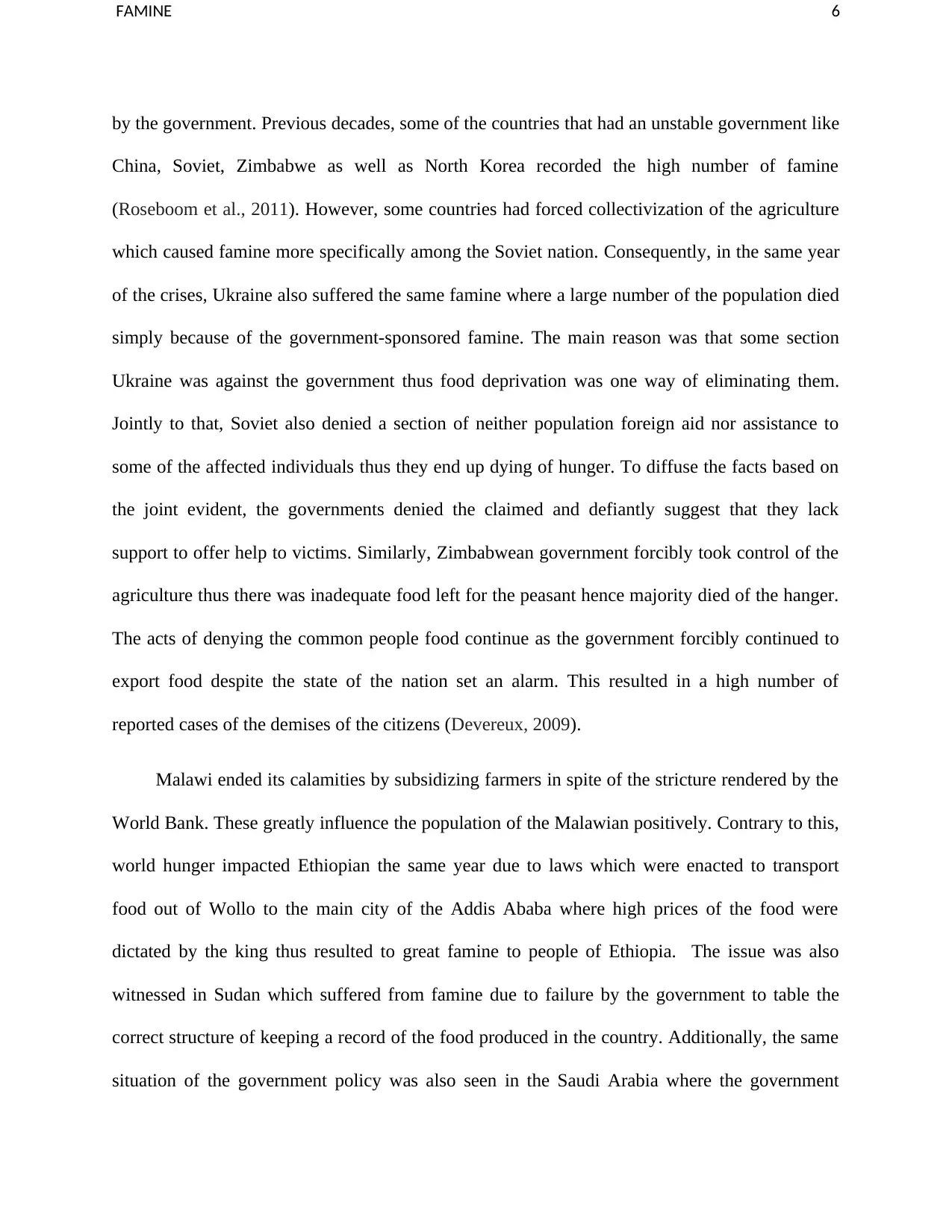
FAMINE 6
by the government. Previous decades, some of the countries that had an unstable government like
China, Soviet, Zimbabwe as well as North Korea recorded the high number of famine
(Roseboom et al., 2011). However, some countries had forced collectivization of the agriculture
which caused famine more specifically among the Soviet nation. Consequently, in the same year
of the crises, Ukraine also suffered the same famine where a large number of the population died
simply because of the government-sponsored famine. The main reason was that some section
Ukraine was against the government thus food deprivation was one way of eliminating them.
Jointly to that, Soviet also denied a section of neither population foreign aid nor assistance to
some of the affected individuals thus they end up dying of hunger. To diffuse the facts based on
the joint evident, the governments denied the claimed and defiantly suggest that they lack
support to offer help to victims. Similarly, Zimbabwean government forcibly took control of the
agriculture thus there was inadequate food left for the peasant hence majority died of the hanger.
The acts of denying the common people food continue as the government forcibly continued to
export food despite the state of the nation set an alarm. This resulted in a high number of
reported cases of the demises of the citizens (Devereux, 2009).
Malawi ended its calamities by subsidizing farmers in spite of the stricture rendered by the
World Bank. These greatly influence the population of the Malawian positively. Contrary to this,
world hunger impacted Ethiopian the same year due to laws which were enacted to transport
food out of Wollo to the main city of the Addis Ababa where high prices of the food were
dictated by the king thus resulted to great famine to people of Ethiopia. The issue was also
witnessed in Sudan which suffered from famine due to failure by the government to table the
correct structure of keeping a record of the food produced in the country. Additionally, the same
situation of the government policy was also seen in the Saudi Arabia where the government
by the government. Previous decades, some of the countries that had an unstable government like
China, Soviet, Zimbabwe as well as North Korea recorded the high number of famine
(Roseboom et al., 2011). However, some countries had forced collectivization of the agriculture
which caused famine more specifically among the Soviet nation. Consequently, in the same year
of the crises, Ukraine also suffered the same famine where a large number of the population died
simply because of the government-sponsored famine. The main reason was that some section
Ukraine was against the government thus food deprivation was one way of eliminating them.
Jointly to that, Soviet also denied a section of neither population foreign aid nor assistance to
some of the affected individuals thus they end up dying of hunger. To diffuse the facts based on
the joint evident, the governments denied the claimed and defiantly suggest that they lack
support to offer help to victims. Similarly, Zimbabwean government forcibly took control of the
agriculture thus there was inadequate food left for the peasant hence majority died of the hanger.
The acts of denying the common people food continue as the government forcibly continued to
export food despite the state of the nation set an alarm. This resulted in a high number of
reported cases of the demises of the citizens (Devereux, 2009).
Malawi ended its calamities by subsidizing farmers in spite of the stricture rendered by the
World Bank. These greatly influence the population of the Malawian positively. Contrary to this,
world hunger impacted Ethiopian the same year due to laws which were enacted to transport
food out of Wollo to the main city of the Addis Ababa where high prices of the food were
dictated by the king thus resulted to great famine to people of Ethiopia. The issue was also
witnessed in Sudan which suffered from famine due to failure by the government to table the
correct structure of keeping a record of the food produced in the country. Additionally, the same
situation of the government policy was also seen in the Saudi Arabia where the government
⊘ This is a preview!⊘
Do you want full access?
Subscribe today to unlock all pages.

Trusted by 1+ million students worldwide
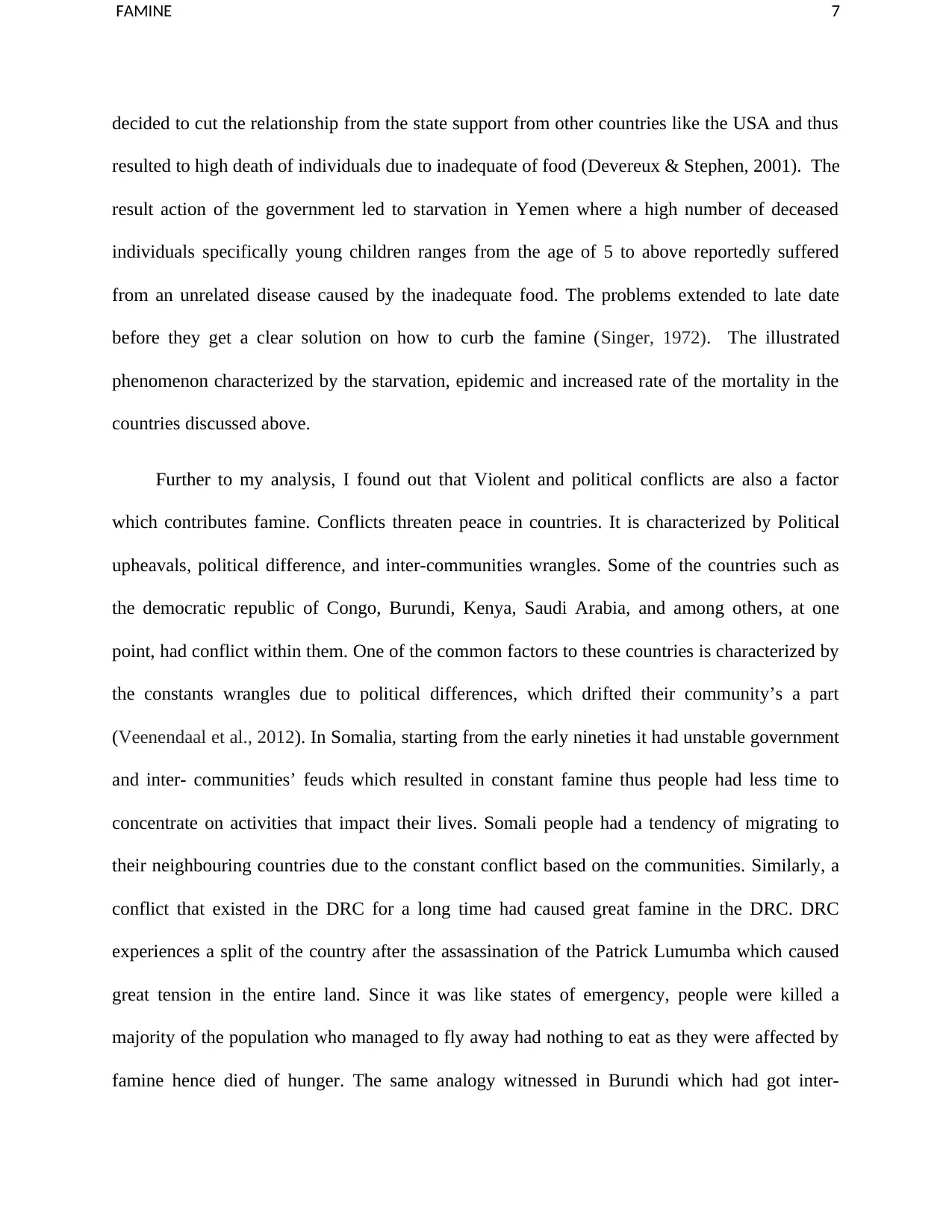
FAMINE 7
decided to cut the relationship from the state support from other countries like the USA and thus
resulted to high death of individuals due to inadequate of food (Devereux & Stephen, 2001). The
result action of the government led to starvation in Yemen where a high number of deceased
individuals specifically young children ranges from the age of 5 to above reportedly suffered
from an unrelated disease caused by the inadequate food. The problems extended to late date
before they get a clear solution on how to curb the famine (Singer, 1972). The illustrated
phenomenon characterized by the starvation, epidemic and increased rate of the mortality in the
countries discussed above.
Further to my analysis, I found out that Violent and political conflicts are also a factor
which contributes famine. Conflicts threaten peace in countries. It is characterized by Political
upheavals, political difference, and inter-communities wrangles. Some of the countries such as
the democratic republic of Congo, Burundi, Kenya, Saudi Arabia, and among others, at one
point, had conflict within them. One of the common factors to these countries is characterized by
the constants wrangles due to political differences, which drifted their community’s a part
(Veenendaal et al., 2012). In Somalia, starting from the early nineties it had unstable government
and inter- communities’ feuds which resulted in constant famine thus people had less time to
concentrate on activities that impact their lives. Somali people had a tendency of migrating to
their neighbouring countries due to the constant conflict based on the communities. Similarly, a
conflict that existed in the DRC for a long time had caused great famine in the DRC. DRC
experiences a split of the country after the assassination of the Patrick Lumumba which caused
great tension in the entire land. Since it was like states of emergency, people were killed a
majority of the population who managed to fly away had nothing to eat as they were affected by
famine hence died of hunger. The same analogy witnessed in Burundi which had got inter-
decided to cut the relationship from the state support from other countries like the USA and thus
resulted to high death of individuals due to inadequate of food (Devereux & Stephen, 2001). The
result action of the government led to starvation in Yemen where a high number of deceased
individuals specifically young children ranges from the age of 5 to above reportedly suffered
from an unrelated disease caused by the inadequate food. The problems extended to late date
before they get a clear solution on how to curb the famine (Singer, 1972). The illustrated
phenomenon characterized by the starvation, epidemic and increased rate of the mortality in the
countries discussed above.
Further to my analysis, I found out that Violent and political conflicts are also a factor
which contributes famine. Conflicts threaten peace in countries. It is characterized by Political
upheavals, political difference, and inter-communities wrangles. Some of the countries such as
the democratic republic of Congo, Burundi, Kenya, Saudi Arabia, and among others, at one
point, had conflict within them. One of the common factors to these countries is characterized by
the constants wrangles due to political differences, which drifted their community’s a part
(Veenendaal et al., 2012). In Somalia, starting from the early nineties it had unstable government
and inter- communities’ feuds which resulted in constant famine thus people had less time to
concentrate on activities that impact their lives. Somali people had a tendency of migrating to
their neighbouring countries due to the constant conflict based on the communities. Similarly, a
conflict that existed in the DRC for a long time had caused great famine in the DRC. DRC
experiences a split of the country after the assassination of the Patrick Lumumba which caused
great tension in the entire land. Since it was like states of emergency, people were killed a
majority of the population who managed to fly away had nothing to eat as they were affected by
famine hence died of hunger. The same analogy witnessed in Burundi which had got inter-
Paraphrase This Document
Need a fresh take? Get an instant paraphrase of this document with our AI Paraphraser
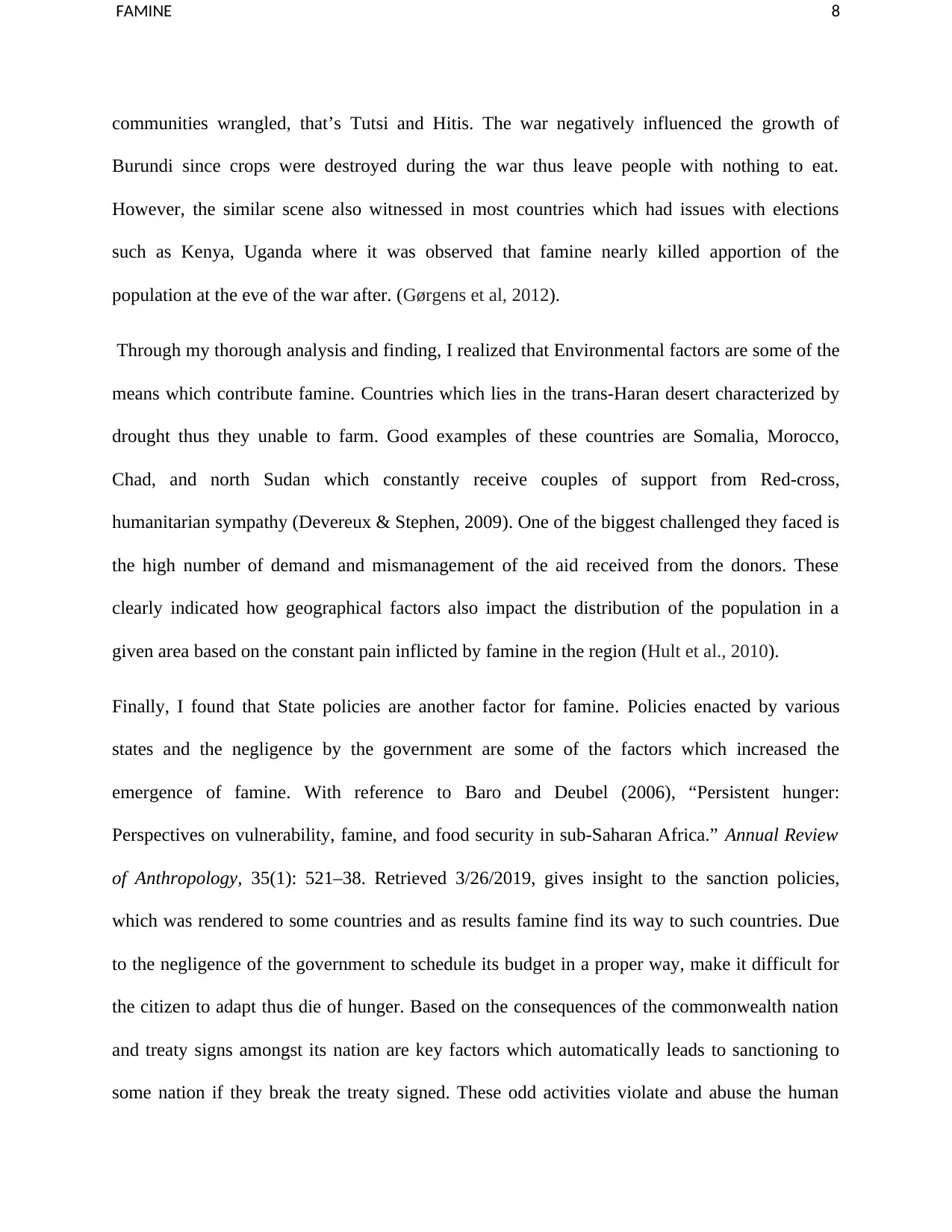
FAMINE 8
communities wrangled, that’s Tutsi and Hitis. The war negatively influenced the growth of
Burundi since crops were destroyed during the war thus leave people with nothing to eat.
However, the similar scene also witnessed in most countries which had issues with elections
such as Kenya, Uganda where it was observed that famine nearly killed apportion of the
population at the eve of the war after. (Gørgens et al, 2012).
Through my thorough analysis and finding, I realized that Environmental factors are some of the
means which contribute famine. Countries which lies in the trans-Haran desert characterized by
drought thus they unable to farm. Good examples of these countries are Somalia, Morocco,
Chad, and north Sudan which constantly receive couples of support from Red-cross,
humanitarian sympathy (Devereux & Stephen, 2009). One of the biggest challenged they faced is
the high number of demand and mismanagement of the aid received from the donors. These
clearly indicated how geographical factors also impact the distribution of the population in a
given area based on the constant pain inflicted by famine in the region (Hult et al., 2010).
Finally, I found that State policies are another factor for famine. Policies enacted by various
states and the negligence by the government are some of the factors which increased the
emergence of famine. With reference to Baro and Deubel (2006), “Persistent hunger:
Perspectives on vulnerability, famine, and food security in sub-Saharan Africa.” Annual Review
of Anthropology, 35(1): 521–38. Retrieved 3/26/2019, gives insight to the sanction policies,
which was rendered to some countries and as results famine find its way to such countries. Due
to the negligence of the government to schedule its budget in a proper way, make it difficult for
the citizen to adapt thus die of hunger. Based on the consequences of the commonwealth nation
and treaty signs amongst its nation are key factors which automatically leads to sanctioning to
some nation if they break the treaty signed. These odd activities violate and abuse the human
communities wrangled, that’s Tutsi and Hitis. The war negatively influenced the growth of
Burundi since crops were destroyed during the war thus leave people with nothing to eat.
However, the similar scene also witnessed in most countries which had issues with elections
such as Kenya, Uganda where it was observed that famine nearly killed apportion of the
population at the eve of the war after. (Gørgens et al, 2012).
Through my thorough analysis and finding, I realized that Environmental factors are some of the
means which contribute famine. Countries which lies in the trans-Haran desert characterized by
drought thus they unable to farm. Good examples of these countries are Somalia, Morocco,
Chad, and north Sudan which constantly receive couples of support from Red-cross,
humanitarian sympathy (Devereux & Stephen, 2009). One of the biggest challenged they faced is
the high number of demand and mismanagement of the aid received from the donors. These
clearly indicated how geographical factors also impact the distribution of the population in a
given area based on the constant pain inflicted by famine in the region (Hult et al., 2010).
Finally, I found that State policies are another factor for famine. Policies enacted by various
states and the negligence by the government are some of the factors which increased the
emergence of famine. With reference to Baro and Deubel (2006), “Persistent hunger:
Perspectives on vulnerability, famine, and food security in sub-Saharan Africa.” Annual Review
of Anthropology, 35(1): 521–38. Retrieved 3/26/2019, gives insight to the sanction policies,
which was rendered to some countries and as results famine find its way to such countries. Due
to the negligence of the government to schedule its budget in a proper way, make it difficult for
the citizen to adapt thus die of hunger. Based on the consequences of the commonwealth nation
and treaty signs amongst its nation are key factors which automatically leads to sanctioning to
some nation if they break the treaty signed. These odd activities violate and abuse the human
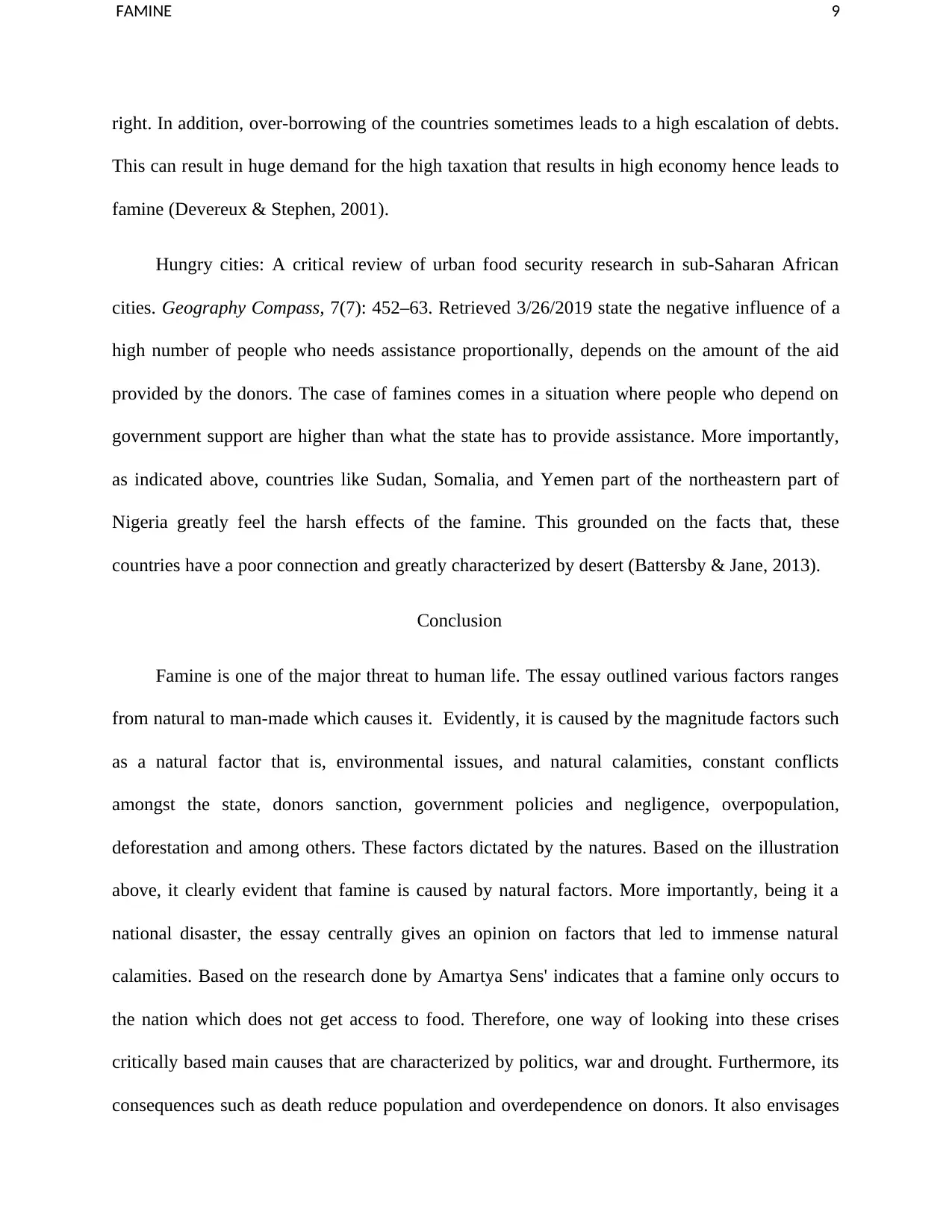
FAMINE 9
right. In addition, over-borrowing of the countries sometimes leads to a high escalation of debts.
This can result in huge demand for the high taxation that results in high economy hence leads to
famine (Devereux & Stephen, 2001).
Hungry cities: A critical review of urban food security research in sub-Saharan African
cities. Geography Compass, 7(7): 452–63. Retrieved 3/26/2019 state the negative influence of a
high number of people who needs assistance proportionally, depends on the amount of the aid
provided by the donors. The case of famines comes in a situation where people who depend on
government support are higher than what the state has to provide assistance. More importantly,
as indicated above, countries like Sudan, Somalia, and Yemen part of the northeastern part of
Nigeria greatly feel the harsh effects of the famine. This grounded on the facts that, these
countries have a poor connection and greatly characterized by desert (Battersby & Jane, 2013).
Conclusion
Famine is one of the major threat to human life. The essay outlined various factors ranges
from natural to man-made which causes it. Evidently, it is caused by the magnitude factors such
as a natural factor that is, environmental issues, and natural calamities, constant conflicts
amongst the state, donors sanction, government policies and negligence, overpopulation,
deforestation and among others. These factors dictated by the natures. Based on the illustration
above, it clearly evident that famine is caused by natural factors. More importantly, being it a
national disaster, the essay centrally gives an opinion on factors that led to immense natural
calamities. Based on the research done by Amartya Sens' indicates that a famine only occurs to
the nation which does not get access to food. Therefore, one way of looking into these crises
critically based main causes that are characterized by politics, war and drought. Furthermore, its
consequences such as death reduce population and overdependence on donors. It also envisages
right. In addition, over-borrowing of the countries sometimes leads to a high escalation of debts.
This can result in huge demand for the high taxation that results in high economy hence leads to
famine (Devereux & Stephen, 2001).
Hungry cities: A critical review of urban food security research in sub-Saharan African
cities. Geography Compass, 7(7): 452–63. Retrieved 3/26/2019 state the negative influence of a
high number of people who needs assistance proportionally, depends on the amount of the aid
provided by the donors. The case of famines comes in a situation where people who depend on
government support are higher than what the state has to provide assistance. More importantly,
as indicated above, countries like Sudan, Somalia, and Yemen part of the northeastern part of
Nigeria greatly feel the harsh effects of the famine. This grounded on the facts that, these
countries have a poor connection and greatly characterized by desert (Battersby & Jane, 2013).
Conclusion
Famine is one of the major threat to human life. The essay outlined various factors ranges
from natural to man-made which causes it. Evidently, it is caused by the magnitude factors such
as a natural factor that is, environmental issues, and natural calamities, constant conflicts
amongst the state, donors sanction, government policies and negligence, overpopulation,
deforestation and among others. These factors dictated by the natures. Based on the illustration
above, it clearly evident that famine is caused by natural factors. More importantly, being it a
national disaster, the essay centrally gives an opinion on factors that led to immense natural
calamities. Based on the research done by Amartya Sens' indicates that a famine only occurs to
the nation which does not get access to food. Therefore, one way of looking into these crises
critically based main causes that are characterized by politics, war and drought. Furthermore, its
consequences such as death reduce population and overdependence on donors. It also envisages
⊘ This is a preview!⊘
Do you want full access?
Subscribe today to unlock all pages.

Trusted by 1+ million students worldwide
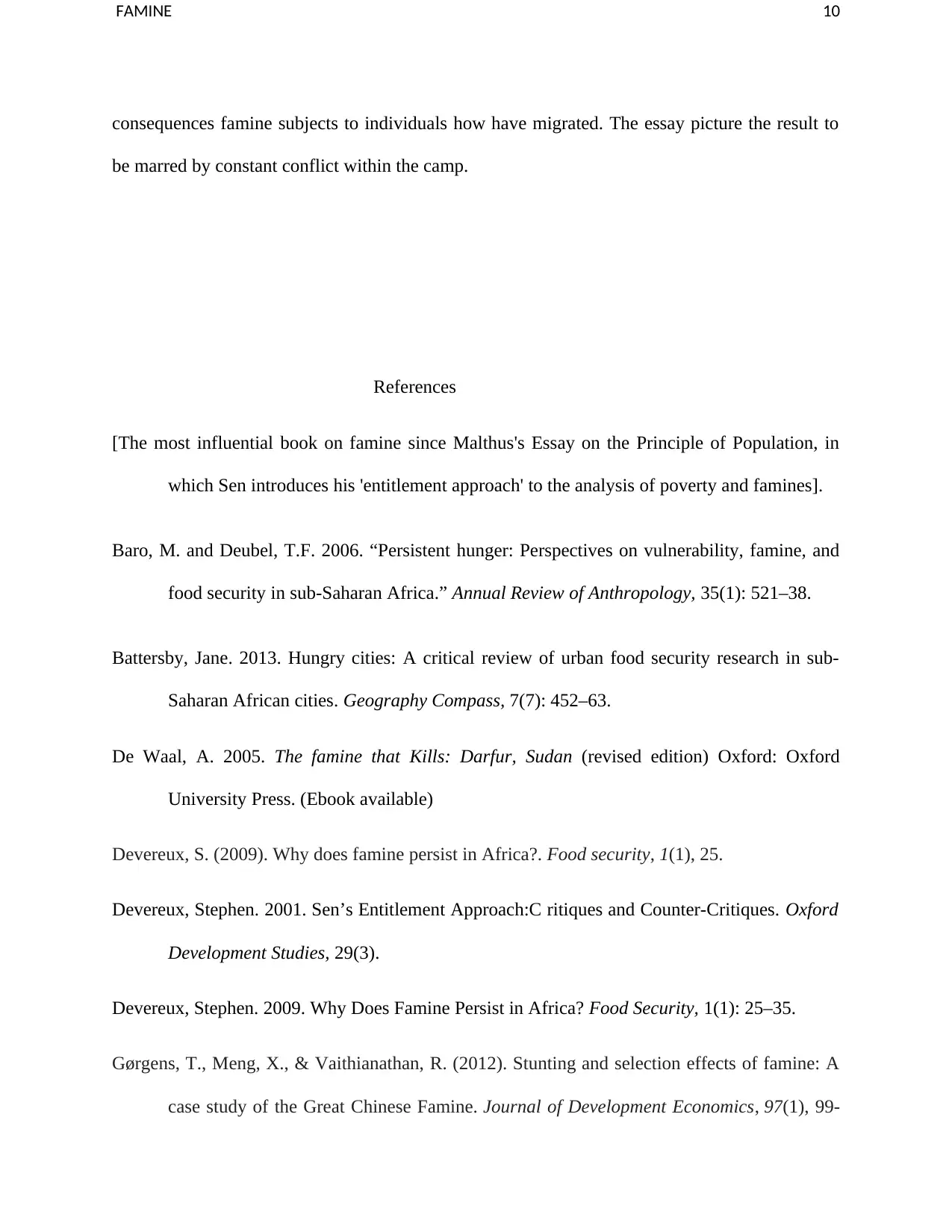
FAMINE 10
consequences famine subjects to individuals how have migrated. The essay picture the result to
be marred by constant conflict within the camp.
References
[The most influential book on famine since Malthus's Essay on the Principle of Population, in
which Sen introduces his 'entitlement approach' to the analysis of poverty and famines].
Baro, M. and Deubel, T.F. 2006. “Persistent hunger: Perspectives on vulnerability, famine, and
food security in sub-Saharan Africa.” Annual Review of Anthropology, 35(1): 521–38.
Battersby, Jane. 2013. Hungry cities: A critical review of urban food security research in sub-
Saharan African cities. Geography Compass, 7(7): 452–63.
De Waal, A. 2005. The famine that Kills: Darfur, Sudan (revised edition) Oxford: Oxford
University Press. (Ebook available)
Devereux, S. (2009). Why does famine persist in Africa?. Food security, 1(1), 25.
Devereux, Stephen. 2001. Sen’s Entitlement Approach:C ritiques and Counter-Critiques. Oxford
Development Studies, 29(3).
Devereux, Stephen. 2009. Why Does Famine Persist in Africa? Food Security, 1(1): 25–35.
Gørgens, T., Meng, X., & Vaithianathan, R. (2012). Stunting and selection effects of famine: A
case study of the Great Chinese Famine. Journal of Development Economics, 97(1), 99-
consequences famine subjects to individuals how have migrated. The essay picture the result to
be marred by constant conflict within the camp.
References
[The most influential book on famine since Malthus's Essay on the Principle of Population, in
which Sen introduces his 'entitlement approach' to the analysis of poverty and famines].
Baro, M. and Deubel, T.F. 2006. “Persistent hunger: Perspectives on vulnerability, famine, and
food security in sub-Saharan Africa.” Annual Review of Anthropology, 35(1): 521–38.
Battersby, Jane. 2013. Hungry cities: A critical review of urban food security research in sub-
Saharan African cities. Geography Compass, 7(7): 452–63.
De Waal, A. 2005. The famine that Kills: Darfur, Sudan (revised edition) Oxford: Oxford
University Press. (Ebook available)
Devereux, S. (2009). Why does famine persist in Africa?. Food security, 1(1), 25.
Devereux, Stephen. 2001. Sen’s Entitlement Approach:C ritiques and Counter-Critiques. Oxford
Development Studies, 29(3).
Devereux, Stephen. 2009. Why Does Famine Persist in Africa? Food Security, 1(1): 25–35.
Gørgens, T., Meng, X., & Vaithianathan, R. (2012). Stunting and selection effects of famine: A
case study of the Great Chinese Famine. Journal of Development Economics, 97(1), 99-
Paraphrase This Document
Need a fresh take? Get an instant paraphrase of this document with our AI Paraphraser
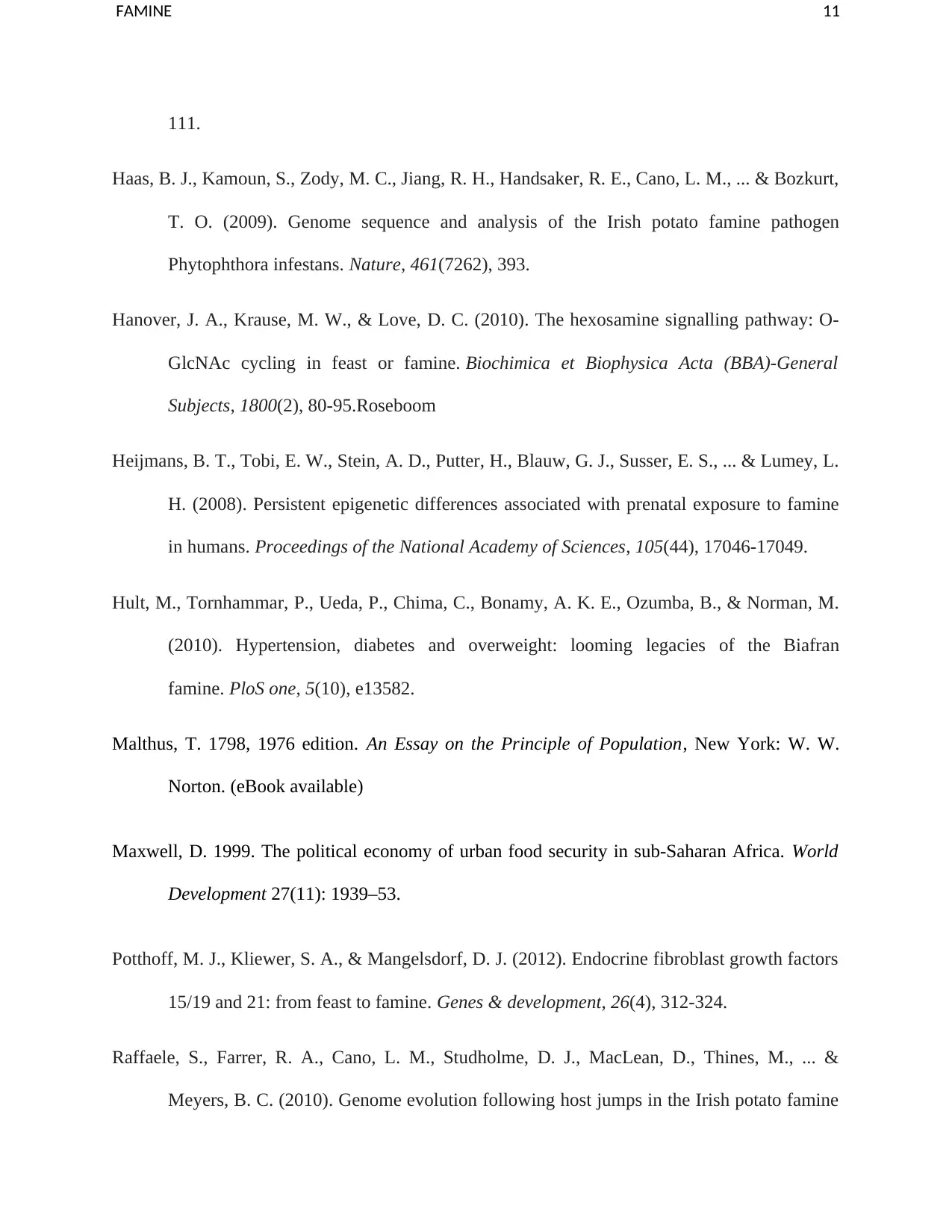
FAMINE 11
111.
Haas, B. J., Kamoun, S., Zody, M. C., Jiang, R. H., Handsaker, R. E., Cano, L. M., ... & Bozkurt,
T. O. (2009). Genome sequence and analysis of the Irish potato famine pathogen
Phytophthora infestans. Nature, 461(7262), 393.
Hanover, J. A., Krause, M. W., & Love, D. C. (2010). The hexosamine signalling pathway: O-
GlcNAc cycling in feast or famine. Biochimica et Biophysica Acta (BBA)-General
Subjects, 1800(2), 80-95.Roseboom
Heijmans, B. T., Tobi, E. W., Stein, A. D., Putter, H., Blauw, G. J., Susser, E. S., ... & Lumey, L.
H. (2008). Persistent epigenetic differences associated with prenatal exposure to famine
in humans. Proceedings of the National Academy of Sciences, 105(44), 17046-17049.
Hult, M., Tornhammar, P., Ueda, P., Chima, C., Bonamy, A. K. E., Ozumba, B., & Norman, M.
(2010). Hypertension, diabetes and overweight: looming legacies of the Biafran
famine. PloS one, 5(10), e13582.
Malthus, T. 1798, 1976 edition. An Essay on the Principle of Population, New York: W. W.
Norton. (eBook available)
Maxwell, D. 1999. The political economy of urban food security in sub-Saharan Africa. World
Development 27(11): 1939–53.
Potthoff, M. J., Kliewer, S. A., & Mangelsdorf, D. J. (2012). Endocrine fibroblast growth factors
15/19 and 21: from feast to famine. Genes & development, 26(4), 312-324.
Raffaele, S., Farrer, R. A., Cano, L. M., Studholme, D. J., MacLean, D., Thines, M., ... &
Meyers, B. C. (2010). Genome evolution following host jumps in the Irish potato famine
111.
Haas, B. J., Kamoun, S., Zody, M. C., Jiang, R. H., Handsaker, R. E., Cano, L. M., ... & Bozkurt,
T. O. (2009). Genome sequence and analysis of the Irish potato famine pathogen
Phytophthora infestans. Nature, 461(7262), 393.
Hanover, J. A., Krause, M. W., & Love, D. C. (2010). The hexosamine signalling pathway: O-
GlcNAc cycling in feast or famine. Biochimica et Biophysica Acta (BBA)-General
Subjects, 1800(2), 80-95.Roseboom
Heijmans, B. T., Tobi, E. W., Stein, A. D., Putter, H., Blauw, G. J., Susser, E. S., ... & Lumey, L.
H. (2008). Persistent epigenetic differences associated with prenatal exposure to famine
in humans. Proceedings of the National Academy of Sciences, 105(44), 17046-17049.
Hult, M., Tornhammar, P., Ueda, P., Chima, C., Bonamy, A. K. E., Ozumba, B., & Norman, M.
(2010). Hypertension, diabetes and overweight: looming legacies of the Biafran
famine. PloS one, 5(10), e13582.
Malthus, T. 1798, 1976 edition. An Essay on the Principle of Population, New York: W. W.
Norton. (eBook available)
Maxwell, D. 1999. The political economy of urban food security in sub-Saharan Africa. World
Development 27(11): 1939–53.
Potthoff, M. J., Kliewer, S. A., & Mangelsdorf, D. J. (2012). Endocrine fibroblast growth factors
15/19 and 21: from feast to famine. Genes & development, 26(4), 312-324.
Raffaele, S., Farrer, R. A., Cano, L. M., Studholme, D. J., MacLean, D., Thines, M., ... &
Meyers, B. C. (2010). Genome evolution following host jumps in the Irish potato famine
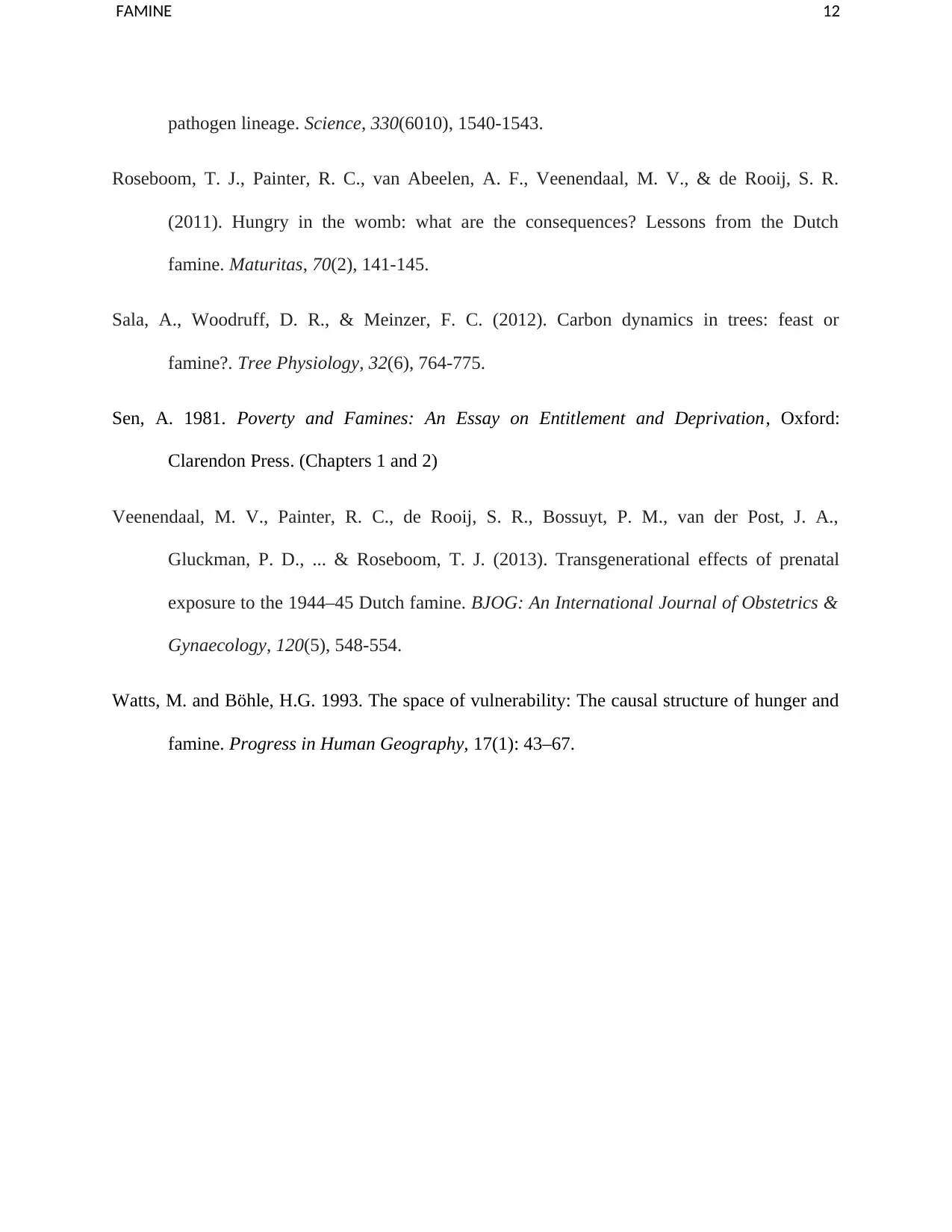
FAMINE 12
pathogen lineage. Science, 330(6010), 1540-1543.
Roseboom, T. J., Painter, R. C., van Abeelen, A. F., Veenendaal, M. V., & de Rooij, S. R.
(2011). Hungry in the womb: what are the consequences? Lessons from the Dutch
famine. Maturitas, 70(2), 141-145.
Sala, A., Woodruff, D. R., & Meinzer, F. C. (2012). Carbon dynamics in trees: feast or
famine?. Tree Physiology, 32(6), 764-775.
Sen, A. 1981. Poverty and Famines: An Essay on Entitlement and Deprivation, Oxford:
Clarendon Press. (Chapters 1 and 2)
Veenendaal, M. V., Painter, R. C., de Rooij, S. R., Bossuyt, P. M., van der Post, J. A.,
Gluckman, P. D., ... & Roseboom, T. J. (2013). Transgenerational effects of prenatal
exposure to the 1944–45 Dutch famine. BJOG: An International Journal of Obstetrics &
Gynaecology, 120(5), 548-554.
Watts, M. and Böhle, H.G. 1993. The space of vulnerability: The causal structure of hunger and
famine. Progress in Human Geography, 17(1): 43–67.
pathogen lineage. Science, 330(6010), 1540-1543.
Roseboom, T. J., Painter, R. C., van Abeelen, A. F., Veenendaal, M. V., & de Rooij, S. R.
(2011). Hungry in the womb: what are the consequences? Lessons from the Dutch
famine. Maturitas, 70(2), 141-145.
Sala, A., Woodruff, D. R., & Meinzer, F. C. (2012). Carbon dynamics in trees: feast or
famine?. Tree Physiology, 32(6), 764-775.
Sen, A. 1981. Poverty and Famines: An Essay on Entitlement and Deprivation, Oxford:
Clarendon Press. (Chapters 1 and 2)
Veenendaal, M. V., Painter, R. C., de Rooij, S. R., Bossuyt, P. M., van der Post, J. A.,
Gluckman, P. D., ... & Roseboom, T. J. (2013). Transgenerational effects of prenatal
exposure to the 1944–45 Dutch famine. BJOG: An International Journal of Obstetrics &
Gynaecology, 120(5), 548-554.
Watts, M. and Böhle, H.G. 1993. The space of vulnerability: The causal structure of hunger and
famine. Progress in Human Geography, 17(1): 43–67.
⊘ This is a preview!⊘
Do you want full access?
Subscribe today to unlock all pages.

Trusted by 1+ million students worldwide
1 out of 12
Your All-in-One AI-Powered Toolkit for Academic Success.
+13062052269
info@desklib.com
Available 24*7 on WhatsApp / Email
![[object Object]](/_next/static/media/star-bottom.7253800d.svg)
Unlock your academic potential
Copyright © 2020–2025 A2Z Services. All Rights Reserved. Developed and managed by ZUCOL.
